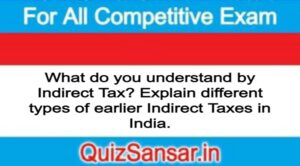
What do you understand by Indirect Tax? Explain different types of earlier Indirect Taxes in India.
What do you understand by Indirect Tax? Explain different types of earlier Indirect Taxes in India.
Ans.
Indirect Taxes
Indirect taxes are those taxes which have their primary burden or impact on a single person. But that person succeeds in shifting his burden to others. In other words, an indirect tax is imposed on one person but is paid partly or wholly by another. Indirect taxes are shifted and the incidence of these taxes falls on persons other than the original payers. Indirect taxes of the Union Government comprise: (i) Customs Duty, (ii) Excise Duty, (iii) CST and (iv) Service Tax.
Indirect taxes are convenient for both the tax-payer and the government. As taxes are paid only when goods are purchased, so, tax-payer does not feel the burden of the tax. This tax is convenient to the government as it collects the amount directly from producers or importers.
Earlier Indirect Taxes in India
Some important indirect taxes prevailed in India were as under:
1. Excise Duty
This duty imposed by the government on the manufacture or production of some goods was called excise duty. The Central Government levied excise duty under the Central Excise Act, 1944 and the Central Excise Tariff Act, 1985. Central excise duty was tax which was charged on such excisable goods that were manufactured in India and meant for domestic consumption. The liability to pay excise duty was always on the manufacturer or producer of goods who collected it from the buyer of goods. Customs Duty.
2. Customs Duty
Duties of customs were levied on goods imported or exported from India at the rate specified under the Customs Tariff Act, 1975 as amended from time to time or any other law for the time being in force. The Customs Act was formulated in 1962 to prevent illegal imports and exports of goods. Besides, all imports were sought to be subject to a duty with a view to providing protection to indigenous industries.
3. Service Tax
The service providers in India were required to pay a service tax under the provisions of the Finance Act of 1994. Under section 67 of this Act, the service tax was levied on the gross or aggregate amount charged by the service provider from the service receiver.
4. Sales Tax
Tax paid by the consumer on the purchase of some items was called the sales tax. Sales tax was imposed under both Central Government (Central Sales Tax) and State Government (Sales Tax) Legislations. From the year 2006, most of the states in India had supplemented sales tax with a new Value Added Tax (VAT).
5. VAT
VAT was a tax on the sale of goods. It was imposed on intra-state sale i.e., sale of goods within the state. It is known as Tax on Value Added or Value Added Tax as it was imposed on the amount of value addition made, mean
Value addition = Sale price-Purchase price.
It was a tax paid on value addition, as the tax paid on purchases was allowed to be set off against the tax payable on sales, the resultant being the tax only on value addition.
2. Explain the concept of GST. Discuss its salient features also.
Concept of Gst (Goods and Services Tax)
GST is a value added tax levied on manufacture, sale and consumption of goods and services. It is a destination-based tax on supply of goods and services, levied at all stages, right from manufacture upto final consumption with credit of tax paid on previous stages available as set-off. GST would accrue to the taxing authority which has jurisdiction over the place of supply.
“GST is a tax on goods and services with value addition at each stage having comprehensive and continues chain of set of benefits from the producer’s/service provider’s point upto the retailer’s level where only the final consumer should bear the tax.
“GST means a tax on supply of goods or services or both except taxes on supply of alcoholic liquor for human consumption.”
GST offers comprehensive and continuous chain of tax credits from the producer’s point/service provider’s point upto the retailer’s level/consumer’s level thereby taxing only the value added at each stage of supply chain.
Since, only the value added at each stage is taxed under GST, there is no tax on tax or cascading of taxes under GST system. GST does not differentiate between goods and services and thus, the two are taxed at a single rate.
GST is a path breaking indirect tax reform which will create a common national market. GST has subsumed multiple indirect taxes like excise duty, service tax, VAT, CST, luxury tax, entertainment tax, entry tax, etc.
Salient Features of Gst
The introduction of Goods and Services Tax (GST) is a very significant step in the field of indirect tax reforms in India. By amalgamating a large number of Central and State taxes into a single tax, it has mitigated cascading or double taxation in a major way and paved the way for a common national market. Introduction of GST has also ‘made Indian products competitive in the domestic and international markets.
(1) GST would be applicable on ‘supply’ of goods or services as against the concept tax on the manufacture of goods or on sale of goods or on provision of services.
(2) Destination based principle: GST is based on the principle of destination based assumption taxation as against the principle of origin based taxation.
(3) Dual GST: It would be a dual GST with the Centre and the States
simultaneously levying it on a common base. The GST to be levied by the Centre would be called Central GST (CGST) and that to be levied by the States [including Union territories with legislature] would be called State GST (SGST). Union territories without legislature would levy Union Territory GST (UTGST).
(4) Inter-State supply: An Integrated GST (IGST) would be levied on Inter-State supply (including stock transfers) of goods or services. This would be collected by the Centre so that the credit chain is not disrupted.
(5) GST on imports: Import of goods would be treated as Inter State supplies and should be subject to IGST in addition to the applicable customs duties.
Import of services would be treated as Inter-State supplies and would be subject to IGST.
(6) Items kept out of GST: GST applies to all goods and services except Alcohol for human consumption. GST on five specified petroleum products (Crude, Petrol, Diesel, ATF and Natural gas) would be applicable from a date to be recommended by the GST Council.
(7) Taxation on Tobacco: Tobacco and tobacco products would be subject to GST. In addition, the Centre would continue to levy Central Excise duty.
(8) Threshold Exemption : A common threshold ‘exemption applies to both CGST and SGST. Taxpayers with an annual turnover of 40 lakh (20 lakh for special category States would be exempt from GST).
(9) Exports are zero-rated : Actually no GST is levied on exports by making them zero-rated taxable.
(10) Input Tax Credit (ITC) to be broad based by making it available in respect of taxes paid on any supply of goods or services or both used or intended to be used in the course or furtherance of business.
(11) Electronic filing of returns by different class of persons at different cut-off dates.
(12) Self assessment: System of self-assessment of the taxes payable by the registered person.
(13) Multiple tax rates: 0%, 3%, 5%, 12%, 18% and 28% in addition cess is applicative on some items.
(14) Advance Ruling Authority is constituted by States in order to enable the taxpayer to seek binding clarity on taxation matters.
(15) TDS and TCS obligations: Tax at the rate of 2% from the payment made or credited to the supplier where total value of supply to government agencies exceeds 2.5 lakh.
Obligation on electronic commerce operators to collect ‘tax at source’, at such rate not exceeding one per cent (1%) of net value of taxable supplies.
(16) Goods and Services Tax Appellate Tribunal is constituted by the Central Government.
(17) An anti-profiteering clause has been provided in order to ensure that business passes on the benefit of reduced tax incidence on goods or services or both to the consumers.
(18) Separate entry of GST in the Tax-invoice which is the basis of ITC.






